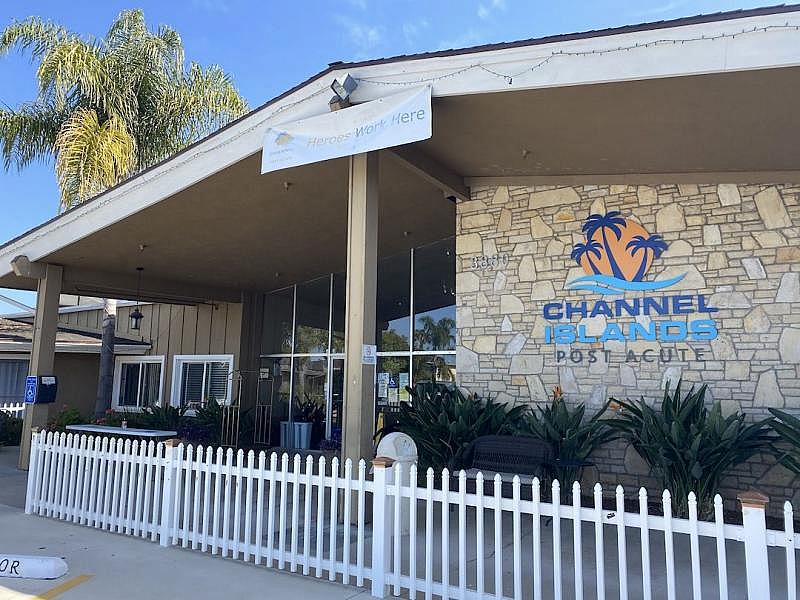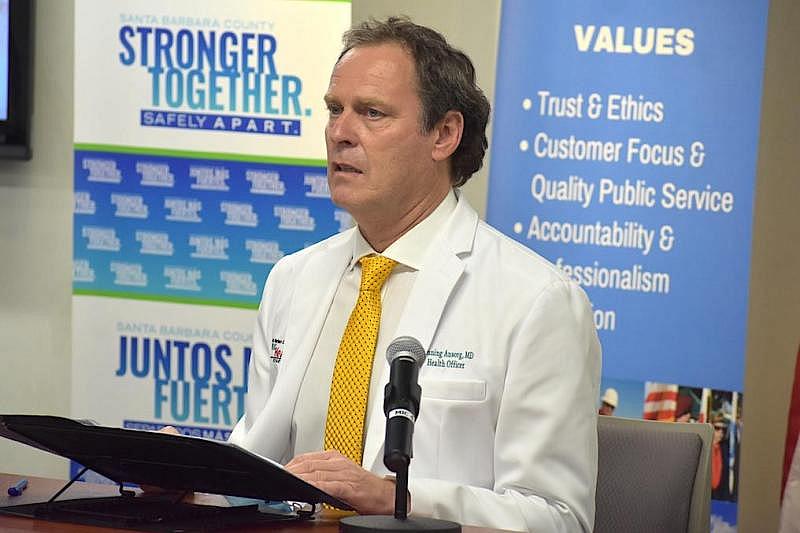Coronavirus ‘spread extremely easily’ in skilled-nursing facilities, with deadly consequences
This story is part of a larger project by Brooke Holland, a 2020 Data Fellow, who is exploring the government and community partnerships in Santa Barbara County to help those at greater risk of contracting COVID-19, such as residents in skilled nursing homes, migrant farm workers, jail inmates, college students and people experiencing homelessness.
Her other stories include:
To Reach Santa Barbara County’s Vulnerable, Public Health Targeted COVID-19 Testing, Drop-In Sites
Santa Barbara County Public Health Partnered with Congregate Facilities on Virus Prevention
In Post-Vaccination Life, Residents Return to Lunches, Events, Visits at Long-Term Care Facilities
Maravilla Senior Living Community Held Earth Day Celebration for First Post-Vaccination Gathering
Prevention Efforts Aimed at Farmworkers Crucial in County’s Fight Against COVID-19
Santa Barbara County Farmworker Advocates, Agricultural Businesses Reflect on Pandemic

Santa Barbara resident Ashleigh Shue, daughter of Joseph Richard Sizoo II, with a family photograph taken during her 2010 wedding at the Santa Barbara County Courthouse. “He was a great dad,” she says of her father, who died in January at the Santa Barbara skilled nursing facility where he was living.
(Brooke Holland / Noozhawk photo)
He had been a resident at the Channel Islands Post Acute skilled nursing facility for about three and a half years. Before the COVID-19 pandemic, and limits on in-person visits, Shue or her brother would go see their dad at least once a week.
She would bring him his favorite treats: M&M’s, Peppermint Patties, Pepperidge Farm Milano cookies, 7 Up and Dr Pepper.
Joseph Richard Sizoo II, a U.S. Navy veteran who went by Richard, enjoyed listening to the rock group U2’s The Joshua Tree album. He owned a pool maintenance business, and loved holidays. He always went over-the-top for Christmas and Halloween, Shue said.
“He was a great dad,” she told Noozhawk.
Shue was able to get her father into the skilled nursing facility, located at 3880 Via Lucero in Santa Barbara, just east of North La Cumbre Road, so he could live closer to her.
When the facility went into pandemic-related lockdown and limited visitation, she would get phone calls from her father periodically.
Like many people who live with dementia, it was challenging for Shue’s father to understand the alternative ways of communicating with a phone call, FaceTime or Zoom video chat.
Family photos of Joseph Richard Sizoo II, as well as his recognition from President Joe Biden for his naval service and his vintage California license plate with his JRS initials. The license plate had been in his room at Channel Islands Post Acute. (Brooke Holland / Noozhawk photo)
“It didn’t translate for him,” Shue said. “It was hard for him to understand. He’s looking at a screen that’s showing my face. It wasn’t the same.”
Staff members at Channel Islands Post Acute would call Shue every time her dad was potentially exposed to a facility worker who had tested positive for the coronavirus, she said.
Shue had received several notifications over the months.
“To be honest, I started to not worry too much about getting those notifications, because it seemed they were happening fairly frequently, and he was fine,” she said.
On a Sunday in January, staff told Shue her father tested positive.
A week later, he died in the facility’s COVID-19 care unit, and family members didn’t get the chance to say goodbye.
Recalling the progression, Shue said she didn’t hear from the facility staff the day after he tested positive.
On Tuesday, she called the facility, and did get in touch with social services.
“They told me that he was doing well,” Shue said.
At that point, she said, she hadn’t been that worried.
Shue called again Wednesday, and staff told her that her dad had stopped eating and drinking, and refused his medication.
“That was a pretty steep decline between Tuesday and Wednesday,” Shue said. “If I hadn’t called to find out what was going on, I don’t know if they would have called me to let me know what was going on.
“They just kept saying that they were monitoring him,” she added.
Around 2 a.m. Saturday, she received a phone call.
“They said he was basically in his final stages of passing,” Shue said. “If we wanted to come see him, we could.”
Shue immediately called her brother.
“We both were kind of scrambling to get ready,” she said. “And literally five minutes later, they called me back and said that he had already passed.”
Sizoo died Jan. 30 at age 74.
Shue never got a chance to see her father or even talk to him after he went into the facility’s COVID-19 unit, she said.
Channel Islands Post Acute is a skilled nursing facility at 3880 Via Lucero in Santa Barbara. (Brooke Holland / Noozhawk photo)
“One of the hardest parts was when you have a loved one in those types of facilities, you have to be their advocate, especially with someone who has dementia or some other type of lowered capacity,” Shue explained.
“It’s almost impossible to do that without physically being there.”
More than 50 residents and 30 staff members have tested positive for the novel coronavirus at Channel Islands Post Acute. Like many other local skilled nursing facilities, it’s unknown how many residents have died of COVID-19, because California does not report the number if it is less than 11.
According to state data, 12 of Santa Barbara County’s skilled nursing facilities, including Channel Islands Post Acute, have reported at least one resident death connected to a COVID-19 outbreak.
Channel Islands Post Acute management declined to comment for this story.
“I have total respect for everyone who works in those facilities,” Shue said. “They have been put under a huge amount of stress and pressure, and I can’t even imagine what they’re dealing with, and putting themselves at risk every day.”
Tracking Congregate-Care Facilities
The Santa Barbara County Public Health Department has reported 170 COVID-19 deaths related to outbreaks in congregate-care facilities.
They account for 38% of the county’s coronavirus-related deaths.
Most of the fatal congregate-care outbreaks happened in long-term care facilities for the elderly, including skilled nursing, assisted living and independent living, according to information obtained by Noozhawk through public records requests.
COVID-19 spreads more easily in communal settings and the specific groups served at these facilities — older adults who often have underlying health conditions — are at increased risk of getting the virus and having severe illness, according to the Centers for Disease Control and Prevention.
“It’s extremely challenging because elderly people who are frail and live in these environments, they have the highest fatality group of all age groups by far,” Dr. Henning Ansorg, the county’s public health officer, said at a Jan. 15 briefing.
He said 25% to 30% of elderly people in congregate settings who were infected with the coronavirus have died of COVID-19.
County public health officials have been supporting staff at these facilities — on-site and remotely — to help prevent and stop the spread of outbreaks.
“But once a facility has a significant outbreak among residents, it is really, really difficult to manage,” Ansorg said.
The CDC’s suggested strategies include mitigating staffing shortages, space limitations and the scarcity of personal protective equipment.
“We took calls from facilities at all times, all days, for many months, and were working with them very closely,” said Stacey Rosenberger, emergency services planner at the county Public Health Department.
Channel Islands Post Acute is a skilled nursing facility at 3880 Via Lucero in Santa Barbara. (Brooke Holland / Noozhawk photo)
“It was spread extremely easily,” added Jan Koegler, an emergency preparedness manager with the department. “Almost despite all efforts, it still continued to spread in the facility. And I would say those facility administrators just worked so hard.”
There are 14 skilled nursing facilities and more than 120 assisted-living facilities in Santa Barbara County, Koegler said.
“We tried to do our best in a situation that is very difficult to control some of these outbreaks,” she said.
Countywide, at least 479 residents and 450 workers at skilled nursing facilities have tested positive for the coronavirus since the pandemic emerged locally.
The county defines an outbreak as one confirmed COVID-19 case reported at a skilled nursing home or assisted-living community, Koegler said.
That threshold is low — other businesses don’t have to report outbreaks unless there are three or more positive cases — because of the high risk involved, according to public health officials.
Regular coronavirus testing — weekly, or more or less often depending on the level of community transmission — is also required for staff at skilled nursing and other congregate-care facilities.
Routine testing is no longer required for fully vaccinated staff members, unless there is an outbreak at the site, according to public health officials.
Outbreaks end — and are “cleared” — after response test results come back negative for two weeks in residents and workers.
Fatal Outbreaks at 24 Congregate Facilities
Twenty-four congregate facilities have reported fatal outbreaks, including residential care facilities for the elderly, independent living facilities, the Lompoc federal prison complex, the Santa Barbara County Main Jail, H-2A housing for agricultural workers, and a supportive housing development.
Most of these fatal outbreaks happened in the summer and the winter months, when positive cases were surging in the community and throughout the state.
The Public Health Department started specifically identifying COVID-19 deaths connected to congregate facility outbreaks in June 2020.
Officials do not name the facilities, with the exception of the Country Oaks Care Center in Santa Maria, which was the first skilled nursing facility to have a fatal outbreak.
Country Oaks, at 830 E. Chapel St. off North College Drive, had the country’s deadliest coronavirus outbreak in June and July, with 12 resident deaths reported.
A second fatal outbreak was reported in mid-December, according to county records obtained by Noozhawk, and 14 total resident deaths were reported for the facility.
Country Oaks Care Center management did not respond to Noozhawk requests for comment on this story.
Dramatic Drop in Cases, Deaths After Vaccination Efforts
New coronavirus cases and COVID-19-related deaths in congregate facilities have dramatically declined since vaccinations began and community transmission decreased countywide.
Vaccination efforts prioritized staff and residents of skilled nursing facilities and assisted-living facilities, and many of them got access in January and February.
The Public Health Department has not reported a positive case among a skilled nursing facility resident since Feb. 22, according to state data.
It’s a different situation for skilled nursing facility staff members, who were initially less likely than residents to say yes to vaccination.
Positive cases among workers are still reported occasionally, according to daily tracking by the county and state public health departments.
— Noozhawk staff writer Brooke Holland reported this story while participating in the USC Annenberg Center for Health Journalism’s 2020 Data Fellowship. She can be reached at bholland@noozhawk.com. Follow Noozhawk on Twitter: @noozhawk, @NoozhawkNews and @NoozhawkBiz. Connect with Noozhawk on Facebook.
[This story was originally published by Noozhawk.]
